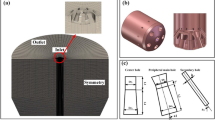Abstract
Titanium removal in a basic oxygen furnace (BOF) converter process was simulated by an experiment in a 500-kg intermediate frequency induction furnace with top- and bottom-blowing functions, and the reaction mechanism of titanium oxidation was investigated. The results showed that the average end point mass percent of titanium in the hot metal was 0.008 2% and the rate of titanium removal was 71.3%. The rate of titanium removal decreased as the temperature of the hot metal increased, whereas it increased with the oxygen supply to the molten pool. The ratio between titanium and manganese is similar to that between titanium and silicon in the hot metal at the end point. However, the titanium content is not associated with carbon oxidation at the end point. The titanium distribution ratio between the slag and hot metal ranges from 0.6 to 1.6, and it increases with the (FeO) content in slag, but decreases as the temperature of the hot metal increases. The experimental results correspond with the theoretical analysis, which conclude that the titanium oxidation reaction is more likely to occur at lower temperatures.
Similar content being viewed by others
References
P. Liao, Z. W. Hou, Z. Qin, X. Z. Zhang, S. T. Qiu, Iron and Steel 48 (2013) No. 1, 30–36.
K. D. Xu, L. J. Xiao, Y. Gan, L. Liu, X. H. Wang, Acta Metall. Sin. 48 (2012) 1–10.
Z. Y. Xu, Z. W. Zhao, B. W. Li, N. Li, J. F. Lu, J. Iron Steel Res. 25 (2013) No. 3, 14–17.
X. H. Huang, Principles of Iron and Steel Metallurgy, 3rd ed., Metallurgical Industry Press, Beijing, 2005.
Z. Z. Liu, W. Wu, B. Ni, T. L. Yao, Y. Yang, Q. He, J. Iron Steel Res. 25 (2013) No. 6, 13–17.
Z. Z. Liu, W. Wu, X. L. Guo, H. D. Meng, J. P. Zhao, Iron and Steel 48 (2013) No. 6, 34–39.
G. Y. Wen, J. Univ. Nat. Sci. Chongqing 22 (1999) No. 2, 115–122.
W. Wu, B. Ni, Z. Z. Liu, J. Univ. Sci. Technol. Beijing 33 (2011) S1, 25–28.
W. Wu, B. Ni, Z. Z. Liu, Y. B. Hu, Y. Yang, China Metallurgy 24 (2014) No. 10, 16–21.
W. G. Lu, M. Lü, H. T. Pan, R. Zhu, H. Z. Wang, Y. Liu, Iron and Steel 49 (2014) No. 5, 36–41.
Author information
Authors and Affiliations
Corresponding author
Rights and permissions
About this article
Cite this article
Wu, W., Ni, B., Liu, Zz. et al. Theoretical study and thermal simulation of titanium removal in combined blown converters. J. Iron Steel Res. Int. 22 (Suppl 1), 57–62 (2015). https://doi.org/10.1016/S1006-706X(15)30139-4
Published:
Issue Date:
DOI: https://doi.org/10.1016/S1006-706X(15)30139-4




